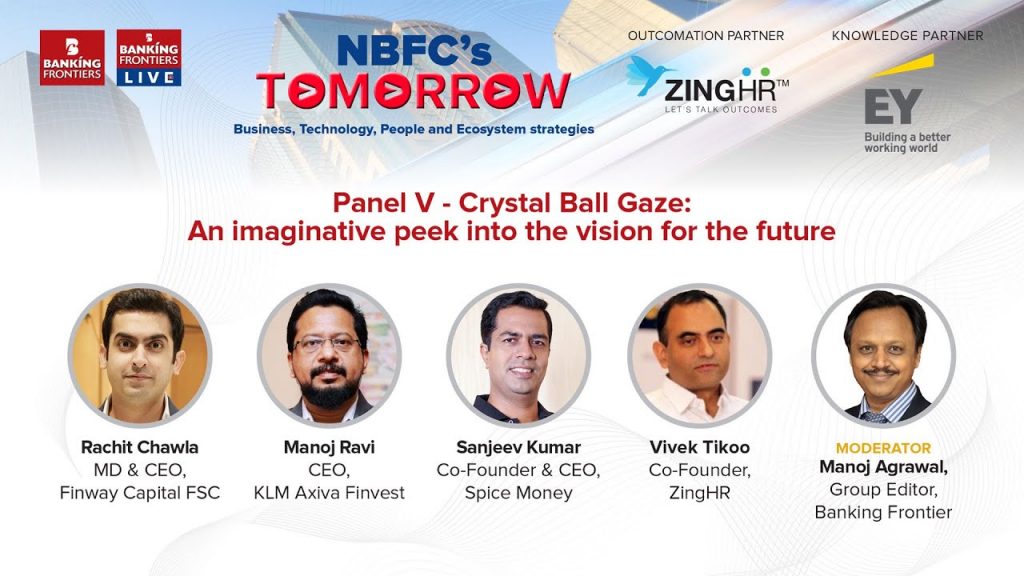NBFCs are reaching out to the last mile of customers who have remained unbanked due to the lack of access, or poor infrastructure. A majority of the NBFCs have made it possible for the people residing in aspirational villages to dream big, lending them credit at shorter notice and with lesser hassle!

Manoj Agarwal, Group Editor, Banking Frontier, discussed the changing dynamics of the NBFC segment in an engaging panel discussion with Rachit Chawla, MD & CEO, Finway Capital FSC; Sanjeev Kumar, Co-founder & CEO, Spice Money; Manoj Ravi, CEO, KLM Axiva Finvest and Vivek Tikoo, Co-founder, ZingHR.
Outlining the scope of the discussion, Agarwal asked the panel its views on the factors shaping the future of the NBFC segment. “In the last 6-12 months, the regulators have been very active in two ways: promoting opportunities for NBFCs to broaden the reach to partners and clamping down on certain practices in certain sectors.”
Growth Factors
The panelists echoed that the government initiatives and the regulators are providing the segment with the impetus for growth. Providing his perspective, Manoj Ravi, CEO, KLM Axiva Finvest, said: “The RBI regulations are good for us, and they will give a lot of impetus to the industry for the next 3-5 years.” RBI has provided a lot of growth saga for all the NBFCs, including big gold loans and smaller, he said.
Rural Landscape & Regulation
The regulator is becoming increasingly active, given the fact more NBFCs are offering loans to the rural sector, which has the maximum number of unserved and underserved customers. They are bundling financial and non-financial services to the rural customers. The rural landscape is adding its own flavor to the NBFC segment.
Take, for instance, Spice Money. According to Sanjeev Kumar, the company’s co-founder & CEO, the enterprise is trying to solve the problem of access for people living in remote blocks and villages. “We serve a million entrepreneurs across 18,000 pin codes, about 25 million consumers, and about $2 billion throughput every month,” he shared.
Speaking on the role of the regulator, he said the regulatory bodies play an important role and provide the much-needed thrust for growth. “The objective of the regulators is to grow business and to protect consumer interest. All the regulations emanate from this point, and that should not change.”
NBFCs that are disregarding the regulation are shutting shop, the panelists warned. They cited a recent instance of the breakdown of mobile apps allegedly launched by Chinese companies that were used to lure and defraud unsuspecting people. “The clampdown was a result of the continuous monitoring by the regulators who are doing an amazing job; giving us the edge to cater to more customers.”
Challenges
While the panelists admitted that rural India provides umpteen opportunities, they highlighted challenges that could hinder the growth potential. The most urgent call for action problem statements included the need for capital which rural India is deprived of, and the need to bridge the gap between collections and credit availability.
“As of now, we have covered 200,000 villages, and we want to go deeper into those villages. In the next 3 years we will cover 600,000 villages which comprises the entire country; that translates to 800 million Indians who are deprived, and lack access to financial services,” said Kumar.
NBFC vs Banks
Since NBFC are a later concept in the country, banks have a first mover advantage and have developed deeper connect with the customers. The NBFC sector must not just compete with banks, but build its own brand and identity.
Rachit Chawla, MD & CEO at Finway Capital FSC, outlined a clear distinction between big banks and the NBFCs. He said that since big banks are bound by too many regulations, they generally do not listen to the customers, or understand the problems that a customer faces. Also, because they are entirely process-driven systems, the turnaround time is too long.
He said: “A bank will lend you money when you do not need it. But when you desperately want to raise money, there are a lot of challenges. That is where we come into the picture.” But the scenario is fast changing. Customers have realized that although NCFCs follow due diligence, TAT is short as the process and the transactions are digital.
The lament is customers treat NBFCs as a stopgap arrangement. Although the churning is faster, the customer relationship teams at NBFCs are developing a rapport with the customers, which builds into personal relationships which are long-standing.
Personalized Services
Personal relationships should be completely transparent. “We have a proprietary in-house technology that provides customers access to the statement of accounts and other services even on a mobile app, like services offered by banks. Secondly, these have also risen co-lending opportunities in which the banks and NBFCs are partnering to reach out to customers,” Chawla said.
HR
As the NBFCs streamline their processes and expand operations to reach out to more customers in the metropolitan and rural areas, they are also upping their HR ante. The value proposition now is to scale the business model and comply with the statutory mandates, pointed out Vivek Tikoo, Co-founder, ZingHR.
Culturally, it is about the perseverance of the core values that the NBFC stands for. So, the value proposition includes key components such as speed, agility, and quick turnaround time versus the traditional banks that are now looking at last-mile inclusion and real-time feedback.
Secondly, globalization is affecting HR policies even in NBFCs. Also, with Gen X and GenZ entering the workforce, the HR practice, and the way an enterprise wants to build its culture have changed, Kumar of Spice Money said.
Blending the old & the new
The entry of the young blood that comes with a fresh and new mindset into the workforce often raises a dilemma: should an enterprise listen to the new or should it abide by experience? It should be a blend of both, the panelists stated.
Comparing the old generation with the new, Chawla of Finway Capital pointed out that while the older generation brings decades of practical experience to the table, the young people come with a professional approach with a focus also on transparency, work-life balance, independence, and regular evaluations.
Ravi of KLM Axiva Finvest, opined that besides regularly updating themselves with the technical knowledge, the youngsters should also acquaint themselves with conventional methods and wisdom of the experienced seniors, for instance, for manual processes. “With a trillion-dollar worth of gold economy in India, 80% of the opportunity is untapped as only 20% of business has been monetized. So, we go with both the generations to scale our business model. And it has been successful. We know that this industry is huge. And the business potential is also huge,” he said.
The success of the NBFCs depends on people and teams inside the organization, and that is where the critical link comes in. “If the NBFCs want to scale up their business, they must build competencies and performance cultures and align that to achieve their business objectives,” Tikoo stated.
___________
Read more-







